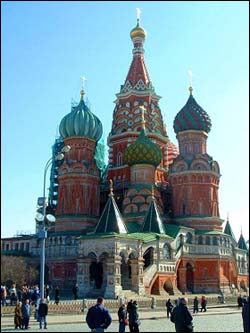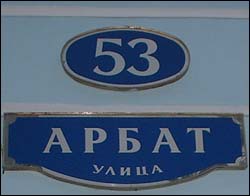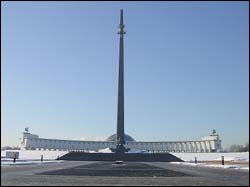 Sightseeing in Moscow
Sightseeing in Moscow |
Red Square is the heart and symbol of Moscow.
It is the most popular place for tourists to visit.
The Kremlin wall and towers, Saint Basil's Cathedral
and Lenin's tomb are must-see spots. The Kremlin
is a symbol of power and used to be the centre
of Russia's church as well as the state. Red Square
is the centre of Moscow, in which is located Lenin's
tomb, built in 1929 at the foot of the Kremlin
wall. It is possible to visit every day except
Mondays and Fridays between 10 a.m. and 1 p.m.
St Basil's cathedral was built in Ivan the Terrible's
time, between 1555 and 1561, in order to commemorate
the victory of the campaign against the Tartar
Mongols.

St. Basils
"Alexandrovsky Sad" is the park just
outside the Kremlin and is a nice place to walk.
It was designed in the beginning of 19th century
by the architect Osip Bove. It is bordered on
the other side by the giant underground shopping
centre and metro station of Okhotny Riad.
One side of Red Square is occupied by GUM, the
state department store, which used to be one of
two state indoor shopping malls during soviet
times, alongside ZUM, or the central state department
store.
Tverskaya Ulitsa is the street leading from Pushkin
Square to Manezhnaya and Red Square. It is currently
full of boutiques and chain stores and you can
see historical monuments from both the 19th century
and Stalin's times.

Old Arbat Street is one of the few pedestrian
areas and oldest streets in Moscow. It is the
place to be for street performers (in the summer!),
street art exhibits and souvenir shops. The buildings
are old merchant houses which create an atmosphere
of old Moscow.
The Pushkin State Fine Arts Museum, the major
foreign art museum, is a monumental building,
on the opposite side of the street from the Cathedral
of Christ the Savior. It is main rival is St Petersburg's
Hermitage.
The Tretyakov Gallery, opposite Gorky Park, is
the most important art gallery in Russia. In the
19th century, Pavel Tretyakov, one of Moscow's
most important personalities, donated over 2000
works from his own collection as well as his house
and surrounding buildings. The Tretyakov Gallery
houses the most celebrated and extensive collection
of Russian art in the world and was a strong institution
for the successful Russian artists.
|
The park of sculptures is outside the Central
House of Artists and contains monuments to soviet
political figures removed from their original
locations after the collapse of the Soviet Union.
The original cathedral of Christ the Saviour
was pulled down during Stalin's anti-religious
campaign in the 1930's. Moscow's current Mayor,
Yuri Luzhkov, decided to rebuild the cathedral
and finished it in 1997. The project was widely
supported by the population but the result caused
controversy. Many claim it is too ugly as the
domes are made of bronze alloy instead of gold
enamel. The cathedral's Georgian architect, Zurab
Tsereteli, is a controversial figure in Russian
contemporary art. He is favoured by Luzhkov (himself
famous for his lack of style!) but disliked by
many Muscovites. Many of his works, like the big,
black, iron statue of Peter the Great on the south
bank of the Moskva, are considered vulgar and
a Novodevichy complete waste of money.
The most famous of Moscow's parks is Gorky Park.
It is a social meeting place and a family fairground,
covering 300 acres of land since 1928. In winter
it is possible to do ice-skating instead of walking
around the park, as many footpaths are flooded.
Victory Park is a huge complex devoted to Russian
victory in WWII. There is a bizarre tradition
of going there on your wedding day. It is a recreation
area for inline-skating, cycling and walking.
At 10p.m., the fountains are coloured red to represent
the spilled blood of the Russian soldiers who
perished during the war.

Victory Park
If you want to see Moscow from the top of a hill,
the best place to go is a special viewing area
at Sparrow Hills not far from Moscow State University,
one of Stalin's 'seven sisters' skyscrapers. On
summer evenings it is also a meeting point for
Russian bikers, where you will see everything
from Harleys to speedy racing bikes.
The Kolomenskoe museum and natural reserve has
churches and 17th century towers and is a nice
place to walk. In the springtime, at Easter or
during pancakes week, there are a lot of outdoor
parties and festivals.
The Novodevichy Convent, was built by prince
Vasili III in 1524. It was built as a forteress,
next to the Moskva river because of the commemoration
of the return of the city of Smolensk to Russia.
Moscow has a long circus tradition and Moscow's
circus is still one of the best in the world.
Moscow also has the only state-owned circus school
in the world, where you can obtain a degree. Students
come from all over the world.
|

